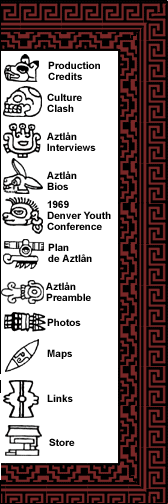

![]()
The Los Angeles Times says of the video "shifting between metaphysical slapstick and probing interviews with historians, anthropologist, community activists and union leaders, the documentary makes a credible case for Aztlán's historic reality, while adding a suitably postmodern, pop-culture spin."What begins as comedic farce concludes with surprisingly thoughtful revelations about the status of Mexican Americans and other Latinos in American society today.
"If we can find this place," Richard Montoya observes in the video, "we can show that Mexican Americans are not foreigners to the United States, but that our ancestors were here before there was a United States."Dr. Yolanda Broyles, one of the scholars interviewed in the documentary part of the video concurs: "The concept of Aztlán marks this identity of Chicanos (Mexican Americans) being here before the establishment of the United States of America, before Plymouth Rock and the Boston Tea party."As they visit such places as California’s Salton Sea, Arizona's Casa Grande Ruins, New Mexico's Chaco Canyon ruins, and the Utah’s Great Salt Lake, the Culture Clash trio discover that, for decades, Aztlán has been an inspiration for human rights activists working in Latino communities throughout the Southwest.
A CHICANO HOMELAND
In the 1960s, responding to years of discrimination and social injustice, the Mexican American descendants of the Aztecs launched a civil and human rights movement for social justice and self-affirmation in the United States. Chicano and Chicana political activists of the 1960s adopted the mythic Aztlán as a symbol for their modern day Chicano nation. Since most Chicanos lived in the Southwestern United States, Chicanos reasoned that they had returned to the homeland of their ancient Aztec ancestors. Pride in this ancient heritage empowered a generation of political activists to champion an American civil rights movement whose positive legacy is still felt today. At the time, few sought to actually locate the physical homeland of their ancestors. Recently, however, scholars have uncovered several historic maps dating as far back as the 1500s which identify several specific locations in the modern states of Utah and Arizona as the possible site of the ancient homeland of the Aztecs (literally, “people of Aztlán”). These early documents suggest that these early map makers were pointing to California, Utah or the Four Corners region as the homeland of the Azteca people.
| <<BACK | NEXT>> |
 |
 |
 |